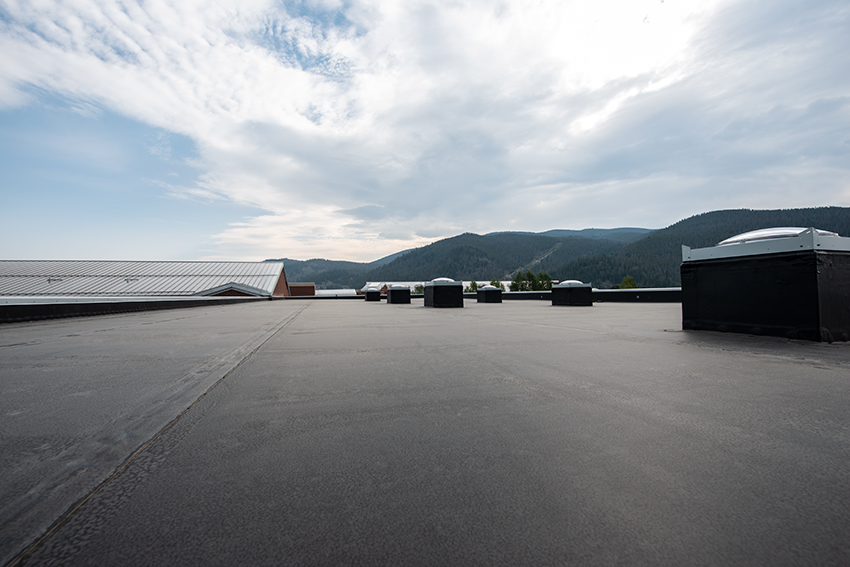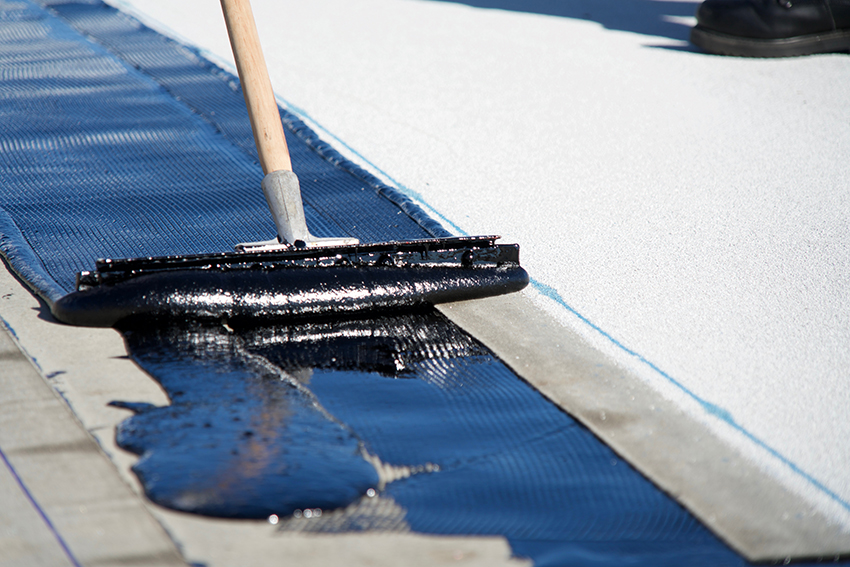Understanding Single-Ply Roofing Systems
Learning Objectives:
- Explain the different material types, properties and characteristics of TPO, PVC and EPDM roofing membranes.
- Describe the different system applications and performance characteristics.
- Identify the flashing and seam-sealing methods for the different roof assemblies available.
- Explore how to match system and installation methods when considering which system best fits your design criteria.
Credits:
Single-ply Roofing Systems for Commercial Applications
When it comes to the design of commercial buildings, more and more architects are opting for low-sloped roofs. Low-sloped roofs cost less to build, reduce the total volume of conditioned air in the building, and conveniently provide an out-of-the-way location for heating, cooling and fire suppression equipment. Specifying a roofing material for low-sloped roofs traditionally meant built-up roofing (BUR) and using asphalt or coal tar. Recently though, variations on single-ply roofing membranes have dominated the market. With so many options, styles, and technologies available, it is more important than ever that architects understand the differences between single-ply roof membrane systems and where best to specify these.

All photos courtesy of Johns Manville
Rubber roofing membrane, known in the industry as ethylene propylene diene terpolymer, or EPDM, is a durable and popular single-ply roofing membrane which can stand up to temperature extremes and moisture.
The main goal of any roofing project is to avoid water penetration. Mitigating damage from a leaky roof is expensive and time consuming. Low-slope roofs are not perfectly flat but have a slight pitch to keep water from pooling. If a roofing membrane develops a hole or if the seams are not sealed adequately, water can cause damage to a roof and eventually find its way into a structure. If a roof pools or leaks, it can cause sagging or deterioration, damage or weakening the roof membrane, and inevitably causing water damage in the structure. Water runoff from rain or snow on a properly designed, constructed and maintained low-slope roof poses few problems. A roof exposed to extreme weather or sudden weather changes, or a roof that is accessed frequently, can have a shorter lifespan. When planning the type of roof for a structure, you want to seek a roof that will perform, but that also is aesthetically pleasing and fits into a budget.
A Walk Through of Roofing Options
Before diving in the world of modern single-ply low-slope roofing options, it’s helpful to have a historical perspective on traditional materials and systems. Though still in use, the last 15 years have shown a significant trend away from built-up roofing and similar systems and the industry has moved rapidly towards single-ply materials.
The “Old Reliable” asphalt roof
BUR is time-tested, and still enjoys some ardent followers today. BUR is installed by imbedding roofing felts in modified hot asphalt. This process is done multiple times, common selections are 3, 4 or 5-layer systems, and then covered with coarse gravel. An updated twist on the BUR is to use a granular cap sheet, or field applied reflective coatings to provide additional thermal and UV protection. Because there are multiple layers involved in installing BUR systems, this choice tends to be robust and durable, but also has a few drawbacks. The binding agent for a successful installation is the asphalt which can be labor intensive to install. Also, the process invariably means that the area in and around the building will have to tolerate the distinct odor of melted asphalt during the installation process. In some situations where high customer traffic must be maintained, the strong fumes can be off-putting and reason enough for building owners to move onto another roofing material option.
Styrene Butadiene Styrene (SBS)
SBS roofing systems are bituminous based systems that have been modified with rubber that enables the material to remain flexible for a wider range of temperatures. This is especially beneficial in colder climates. SBS has been around since the mid-1970’s and has four primary installation options including torch, hot asphalt, cold applied and even self-adhering rolls. Because of the multiple installation options, SBS can be installed year-round regardless of ambient air temperatures, a handy option when construction dates shift to cooler months. These rolls are reinforced with usually polyester or fiberglass which makes the material very durable, while also allowing for customizations to satisfy specific design needs. On the down side, SBS does not weather well if constantly exposed to a high level of oil or hydrocarbon-based chemicals. Also, installation costs can require a longer return on investment window, meaning short-term owners looking to “flip” a property may not want to shoulder the initial cost. Another consideration with SBS is that it is important that an experienced (and certified) contractor be selected for the installation process.

SBS can be cold applied, as shown, but it is also suitable for heat welded, self-adhered, mechanically fastened and hot applied applications.
Atactic Polypropylene (APP)
APP is designed to have a higher softening temperature, and is ideal for installation in hotter climates. The basic chemistry is similar to SBS, but can be more brittle at colder temperatures. The bituminous material has been modified with a crystalline plastic which allows it to remain stiff in high temperature situations, and ideal attribute for areas that experience both extreme heat and strong wind events. The resistance to heat means that there are only two viable installation methods, cold adhesive or torch application. Most APP systems include polyester reinforced backing and fiberglass reinforced which gives the material a higher tear strength. While APP systems perform well in high temperature regions, they are not recommended for cold climates, and due to the technical nature of the installation process, fewer qualified contractors are available for projects.
The Rise of Single-ply
BUR systems require multiple layers of roofing material and asphalt in order to create a waterproof and durable surface. Likewise, SBS and APP systems utilize multiple layers including a base ply, and an adhesive layer under the SBS or APP cap ply to finish the installation.
By contrast, single-ply roofing materials can be installed directly on the approved roofing substrate. This can drastically reduce installation time, material costs and also allow for easier installation. The performance, cost and installation advantages of single-ply materials compared to traditional multi-layered systems has greatly increased their acceptance in the market. However, to fully appreciate the advantages of single-ply roofing materials, it is important to understand the variations in single-ply products and how they are produced.
There are three popular types of single-ply low-slope roof projects: EPDM, PVC and TPO.
EPDM - Cured Ethylene Propylene Diene Monomer
The development of EPDM, or rubber roofing, offered a system that is typically easier and more efficient to install than asphalt or coal tar BUR. The first EPDM roof membrane was created in 1965, two years after EPDM rubber production began. EPDM, as a roofing material, is traditionally black and has the same feel as the rubber used in tire inner tubes. In the early 1980s, white EPDM became available as a color choice, and butyl-based adhesives replaced the neoprene-based adhesives. Several years later, reinforced EPDM entered the United States market. In 1992, reinforced fastening strips and seam tape replaced seam adhesives.
Raw materials used to create EPDM include equal parts polymer and carbon black (for UV resistance), comprising about 50-60 percent of the formula. The rest is of the materials generally are used for processing, fire resistance and stability.
During manufacturing, the thermoset EPDM is created through the chemical cross linking of polymers, or molecular chains. A distinguishing characteristic is that EPDM can only be bonded to itself during installation by use of an adhesive or tape because, once cured, new molecular linkages cannot be formed. The material can be extruded or calendered into sheet form and can be reinforced with a polyester scrim for higher tear strength performance. It is important to note that extruded sheets have fewer pockmarks and air inclusions than calendered sheets.
EPDM performs well because it is highly UV stable due to the carbon black and has relatively high installation efficiency and consistency. The installation of thermoset and thermoplastic materials will be discussed in depth later in this article.
Polyvinyl Chloride (PVC)
Also called vinyl, PVC is composed of ethylene and chlorine. In its compounding process, vinyl resin is blended with biocides, color pigments, heat stabilizers, ultraviolet light inhibitors and plasticizers. PVC is recyclable and fire-resistant, and it uses fewer petrochemicals than other roofing systems.
A PVC roof consists of a single-ply membrane composed of two layers of PVC material covering a reinforcement scrim. The top layer is UV-resistant and flexible and can take on color through pigmentation. The bottom ply is often grey or black PVC and contains more plasticizers for flexibility and weldability. The reinforcements for PVC are typically polyester or fiberglass (when not mechanically fastened) and are added to provide increased strength, longevity and dimensional stability performance enabling the material to be a long-term, proven roofing solution with multiple installation options.
After a century of fine tuning and technological improvements to the workable flexibility by the inclusion of plasticizers, in 1985 PVC became the first single-ply roofing system to earn a standard from what is now ASTM International—ASTM D4434. At present, all commercial PVC roofing membranes are reinforced.
Thermoplastic Polyolefin (TPO)
TPO was introduced in the 1980s. TPO includes polymers as delineated in ASTM D5538.
In the polymer manufacturing process, polypropylene with ethylene-propylene rubber are polymerized; the polypropylene improves weldability and the ethylene-propylene enhances durability. This polymer is then used with other key ingredients like fire retardants, UV stabilizers, antioxidants, and pigments to produce TPO roofing membranes. Typical TPO incorporates both a cap and core membrane with a polyester reinforcing scrim encapsulated between these layers. The cap is up to 75 percent TPO polymer with 25-35 percent fire retardants, as well as small amounts of pigment and UV stabilizers. The core membrane is similarly composed but includes up to 15 percent recycled TPO and it doesn’t need UV protection.
Thermoplastic roof membranes, both PVC and TPO, can be produced in three ways: calendering, spread coating, or extruding. The extrusion process, which was developed from and improves on calendaring, is most common. In extrusion, the formulation is heated then forced through an extruder die onto the reinforcing fabric. From there the sheet continues through some calender rolls and the second layer is then applied in the same fashion as the first. The reinforcement is now encapsulated in the thermoplastic membrane between cap and core and can be processed into a finished roll good. There are generally two formulations of PVC membranes. One contains only PVC. The second involves a product developed by DuPont called Elvaloy KEE. Mixed with PVC, Elvaloy is a soft, high-molecular-weight polymer plasticizer.









